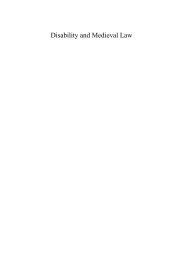Sample pdf - Cambridge Scholars Publishing
Sample pdf - Cambridge Scholars Publishing
Sample pdf - Cambridge Scholars Publishing
Create successful ePaper yourself
Turn your PDF publications into a flip-book with our unique Google optimized e-Paper software.
14<br />
Chapter One<br />
1.2 Surveying<br />
The domain of surveying is very challenging for terminologists<br />
because of discrepancies in the naming of the field and its complex<br />
structure. The name of the field has evolved over time from land surveying<br />
to surveying and geomatics. A lack of international agreement as to how<br />
the field should be named and different naming conventions, both in<br />
continental Europe and the Anglo-Saxon countries, has increased the<br />
number of different labels used for the field. Furthermore, the field of<br />
surveying can be divided into a number of subdomains, e.g. cadastral<br />
surveying, plane surveying. Different classification schemes provide an<br />
overview of the field, but they often differ significantly in the subfields<br />
they specify.<br />
In this section I will look at differences in the naming of the field and<br />
analyse a range of labels under which the field is known (1.2.1). I also<br />
compare and contrast classification schemes in surveying (1.2.2) and I<br />
attempt to develop a uniform classification system for this field (1.2.3)<br />
based on the analysis in the first two subsections.<br />
1.2.1 Differences in the naming of the field<br />
The term surveying is quite ambiguous as the field is named, perceived<br />
and understood differently in different countries, with notable differences<br />
existing between the continental European tradition and the Anglo-Saxon<br />
tradition. The field is named surveying (formerly land surveying) in the<br />
Anglo-Saxon tradition (Ghilani & Wolf, 2008, p. 1) and geodesy in the<br />
European tradition (Hycner & Dobrowolska-Wesołowska, 2008, p. 16). I<br />
will try to provide definitions and examples of usage of these terms in<br />
order to find differences in the meaning between them.<br />
I will now look at how these terms are described in a number of<br />
textbooks on surveying, encyclopaedias and standards. In the case of<br />
surveying, I have an article by Lyman and Wright (2009) in the<br />
Encyclopaedia Britannica and a surveying textbook by Bannister et al.<br />
(1998). According to Lyman and Wright (2009), surveying is a method of<br />
making relatively large-scale, accurate measurements of the Earth’s<br />
surface. Its principal modern uses are in the fields of transportation,<br />
building, land use, and communications. Surveying is divided into plane<br />
surveying, which deals with mapping small areas, such as a building site<br />
or a parcel, and geodetic surveying, which focuses on mapping large areas<br />
of the globe, e.g. the territory of a country. The definition of surveying by<br />
Bannister et al. (1998) and the division of surveying into geodetic and
















